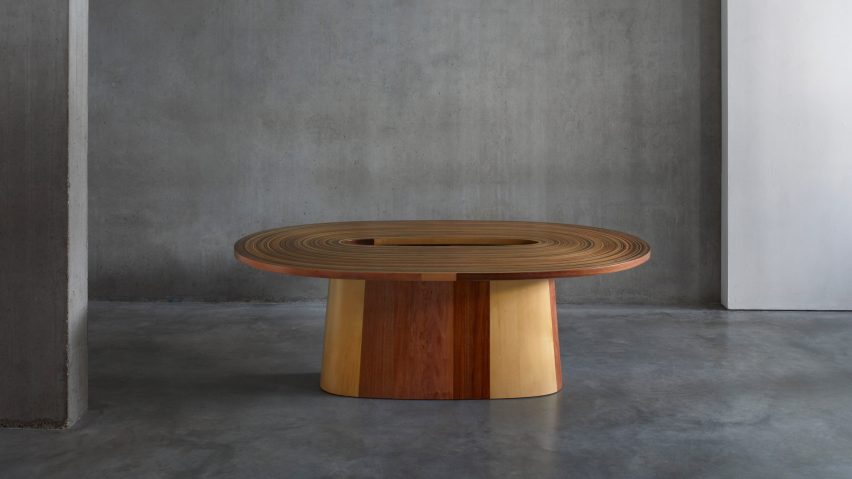London-based designer Brodie Neill has used over three kilometres of veneer taken from trees in a flooded forest in Tasmania to create the top of ReCoil, an oval dining table.
The designer used timber salvaged by Hydrowood, a company that specialises in harvesting timber underwater, to create the ReCoil table and a number of other items of furniture.
The trees were lost underwater in the 1980s when an area of virgin forest was flooded during the creation of a hydroelectricity scheme, creating Lake Pieman.
The table features veneers of huon pine, eucalyptus, Tasmanian oak, celery top pine, sassafras, myrtle and blackwood, which are all native to the Pieman River valley.
In an interview with Dezeen's founder Marcus Fairs during London Craft Week, Neill shared how the wood is extracted from the water.
"A company called Hydrowood has devised a way using modern technology to scan the lake by the riverbed to see the timbers that are there," he said.
"They're able to scan to see what it is and literally cut the tree off at the riverbed and pull them out of the water."
The Tasmanian timber sourcing company uses a barge with a crane attached to reach far into the lake where it cuts the tree at its base before extracting the wood from the water. This method leaves the river bed largely undisturbed.
Veneers from the various species of trees were then sent to London where Neill, who was born in Tasmania, has his studio.
"I was interested in trying to make use of the smaller and the forgotten pieces – the pieces that were discarded a lot from panel production and so on," he explained.
"The veneer is also the most economical form to be able to transport the material and obviously this has come from Tasmania and my studio is here in London."
A randomised algorithm set the patterns of the multi-hued veneers for Neill to combine to create the stripey tabletop.
Using his "hands-on" approach to craftsmanship, he spent 60 hours hand coiling the strips of wood. If the pieces were laid side by side, they would measure three and a half kilometres long.
The lengthy process was in part due to the fact that working with wet wood forced the designer to adopt a more considered, careful approach.
This is the first time Neill has worked with material from his native country and using the wood proved to be a cathartic practice that reminded him of home.
"When working with [the woods], the aromas that they were giving off really took me back to those four years of art school and those are the building blocks of my career," he recalled.
Coiling the veneers similarly gave Neill a nostalgic feeling, prompting him to call the table ReCoil for its connotations with remembering and reconnecting.
"It's been a kind of connection of literally laying the layers around and around," he said. "The process of actually kind of laminating it up was very therapeutic in a way so it was a real moment to kind of grow and reconnect."
The table isn't the first piece of furniture that Neill has created that explores the relationship between material and waste.
The designer used ocean plastics to create a terrazzo-effect table called Gyro, while his Stella Nova table for London studio Made in Ratio was made from recycled aluminium and bamboo.
ReCoil was exhibited together with other furniture pieces by Neill at an exhibition presented by Design Tasmania during London Craft Week.
London Craft Week 2021 took place at venues across London from 4 to 10 October. For details of more architecture and design events, visit Dezeen Events Guide.

